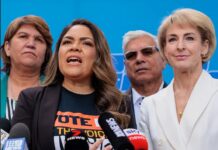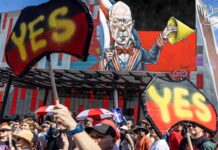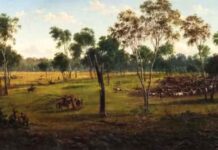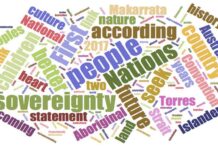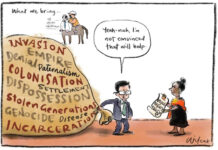The truth of Australia’s history has long been hiding in plain sight.
The stories of “the killing times” are the ones we have heard in secret, or told in hushed tones. They are not the stories that appear in our history books yet they refuse to go away.
The colonial journalist and barrister Richard Windeyer called it “the whispering in the bottom of our hearts”. The anthropologist William Stanner described a national “cult of forgetfulness”. A 1927 royal commission lamented our “conspiracy of silence”.
But calls are growing for a national truth-telling process. Such wishes are expressed in the Uluru statement from the heart. Reconciliation Australia’s 2019 barometer of attitudes to Indigenous peoples found that 80% of people consider truth telling important.
Almost 70% of Australians accept that Aboriginal people were subject to mass killings, incarceration and forced removal from land, and their movement was restricted.
The Killing Times is a Guardian Australia special report that aims to assemble information necessary to begin truth telling – not just the grim tally of more than a century of frontier bloodshed, but its human cost – as told by descendants on all sides. This is the history we have all inherited.
 Our interactive map details massacres in every state and territory but the research is ongoing. It does not count all the sites of conflict, or clashes over land and resources, in which lives were lost in the colonisation of Australia.
Our interactive map details massacres in every state and territory but the research is ongoing. It does not count all the sites of conflict, or clashes over land and resources, in which lives were lost in the colonisation of Australia.
The numbers we have drawn on are conservative estimates.
There are more massacre sites to be added – places where the true death toll may never be known – and many more we are still working to verify, particularly in Queensland, Western Australia, the Northern Territory and New South Wales.
In this first snapshot of the continent, we have found that there were at least 270 frontier massacres over 140 years, as part of a state-sanctioned and organised attempt to eradicate Aboriginal people.
 Starting in 1794, mass killings were first carried out by British soldiers, then by police and settlers – often acting together – and later by native police, working under the command of white officers, in militia-style forces supported by colonial governments.
Starting in 1794, mass killings were first carried out by British soldiers, then by police and settlers – often acting together – and later by native police, working under the command of white officers, in militia-style forces supported by colonial governments.
These tactics were employed, without formal repercussions, as late as 1926.
Using data from the colonial massacre map at the University of Newcastle’s Centre for 21st Century Humanities, and adopting its stringent research methods, Guardian Australia has surveyed the rest of the country.
- Government forces were actively engaged in frontier massacres until at least the late 1920s.
- These attacks became more lethal for Aboriginal people over time, not less. The average number of deaths of Aboriginal people in each conflict increased, but from the early 1900s casualties among the settlers ended entirely – with the exception of one death in 1928.
- The most common motive for a massacre was reprisal for the killing of settler civilians but at least 51 massacres were in reprisal for the killing or theft of livestock or property.
- Of the attacks on the map, only once were colonial perpetrators found guilty and punished – in the aftermath of the Myall Creek killings in 1838.
- In NSW and Tasmania between 1794 and 1833, most of the 56 recorded attacks were carried out on foot by detachments of soldiers from British regiments, and an average of 15 people were killed in each one. The weapon most often used was the “Brown Bess” musket, which was issued to British forces in the Napoleonic wars.
- In NSW and Victoria between 1834 and 1859, horses and carbine rifles were used in at least 116 frontier massacres of Aboriginal people in mostly daytime attacks, with an average of 27 people killed in each attack.
- From the late 1840s, massacres were carried out as daylight attacks by native police, sometimes in joint operations with settlers. They most often used double-barrelled shotguns, rifles and carbines.
- Preliminary data from Queensland shows that between 1859 and 1915 an average of 34 people were killed in each attack.
- There are at least nine known cases of deliberate poisoning of flour given to Aboriginal people.
There were also efforts to cover up the atrocities.
In 1927 a royal commission into the Forrest River massacre in Western Australia concluded that a police party had killed at least 11 people then burned their bodies in makeshift ovens. In his report the commissioner, GT Wood, said a “conspiracy of silence” in the entire Kimberley district had thwarted attempts to find out what really happened.
These massacres are challenging to read about. It can be even more challenging to discover a personal or family connection to them. Nevertheless, many Australians have come forward to share their stories, some for the first time.
Sandy Hamilton is descended from a soldier in the 46th Regiment which, on orders of the NSW governor Lachlan Macquarie, killed at least 14 Aboriginal people at Appin in 1816.
“We need to take ownership of our history,” Hamilton says. “We deserve to know the truth of how we came to be who we are.
“Then we can also make real choices about who we want to be as a society, as Australians.”
This map shows evidence of mass killings from 1788 until 1928: a sustained and systematic process of conflict and expansion.
Data used in this map is reproduced with permission of the University of Newcastle Colonial Frontier Massacres Project team.
This site is a collection of as much accurate information as we can provide at this time about what took place on the frontier of colonisation. What happened near your suburb, town or district? Search by location, postcode or time to find out.
The process of truth-telling is ongoing. Verifying sites takes time and care. To find out what we did and why, read the “About” section. “Tips” will help you navigate the map and its features.
We will update this site as more information comes to light. You can contact us about this project at killingtimes@theguardian.com.
A warning: this contains information about acts of violence, strong themes and archaic language.
“It happened all over Australia and this is a part of our history,” Dale-Hallett says. “I’ve got a direct connection to it – but that doesn’t make it my history and not yours.
“Part of the reason they are continuing to cause harm is they haven’t been properly acknowledged. The simple act of listening is a really important first step in a more complex conversation that needs to be had about how did Australia settle itself.”




